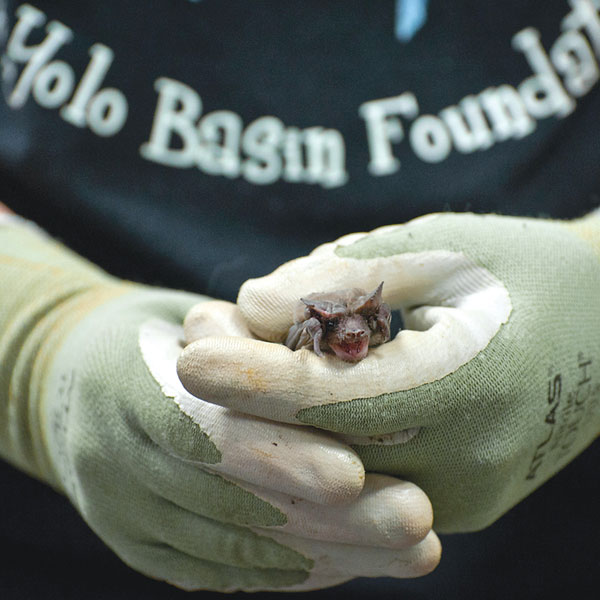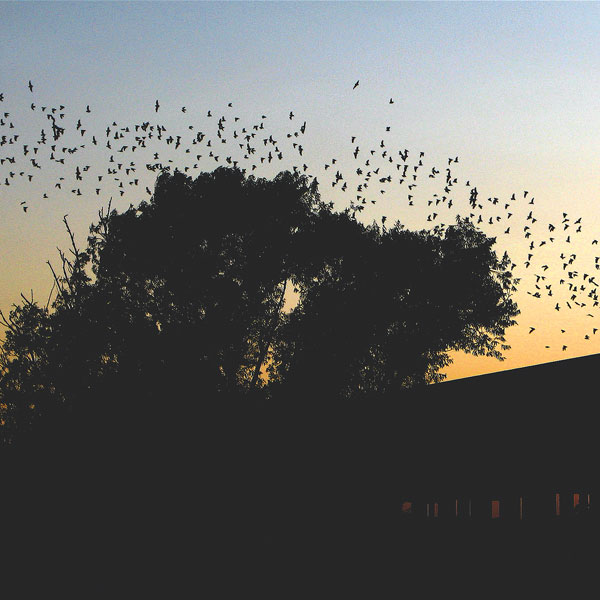I expected the sky to move in waves of solid black, back and forth, around and under—the air to be filled with spine-shivering screeches.
But that’s not what happened.

Our group of 12 met up with two guides at the Cosumnes River Preserve off of Franklin Boulevard in Galt. After a quick orientation, we took a paved path to a row of kayaks and then glided down the river’s main channel, through a riparian forest and wetlands. By the time we reached our destination it was dusk, the appointed time for tens of thousands of Mexican free-tailed bats to emerge from under a circa 1950 redwood-beam bridge in search of their nightly meal of insects.
But instead of the frightening and frantic scene I expected, the nocturnal mammals streamed out in long curling ribbons from beneath the bridge, taking a full 20 minutes for the last one to appear. The sky wasn’t thick with black bodies. In a delicate and intricate dance, the bats spread out across the sky, disappearing into the woodlands for moths and mosquitos, and darting over the water for dragonflies.
And the air was hushed—barely a sound as the summer sun faded away.
Bats have received a lot of attention in the last few months due to their possible link to the novel coronavirus. Coronaviruses are a large family of viruses common in people and many different species of animals, including bats, according to the Centers for Disease Control and Prevention.
While it’s still unknown how the coronavirus that causes COVID-19 jumped from animal to human, the general consensus is the virus did not spread directly from bats to people. Instead, one or more animals at a live wildlife market, also known as a “wet market,” in Wuhan, China, was likely infected by a bat, specifically China’s horseshoe bat, at some point.
Humans then came in contact with that infected animal at the market, where legal and illegal wildlife and domestic pets are packed tightly into cages in stressful and unsanitary conditions, slaughtered and sold for food. “Live animal markets and trafficking in wild animals is at the heart of this global health threat,” according to Bat Conservation International.
“There is no evidence that suggests bats found in North America harbor these types of coronaviruses,” says Mary Jean “Corky” Quirk with Northern California Bats, a volunteer group dedicated to rescuing and rehabilitating injured and orphaned bats in Sacramento Valley and surrounding foothills. “There is no reason to fear bats. They are amazing mammals whose bodies have adapted to live with certain viruses.”
In fact, NorCal Bats has received direction from the state of California to protect bats from humans. Due to concerns that the virus could transfer back from humans to bats in North America, the government has recommended scientists suspend research that involves capturing or handling bats. NorCal Bats can continue to accept bats that need care, but is not allowed to release them back into the wild until further notice.

Bat colonies that once numbered in the millions have been dramatically reduced due to human disturbance and habitat destruction, as well as pesticide poisoning, according to the Yolo Basin Foundation. “Things like deforestation, degradation of habitat, capturing wildlife for the exotic pet trade, and mixing captive wildlife and domestic animals in confined areas. All of these lead to stress and the shedding of viruses,” Quirk says.
There are more than 1,400 species of bats in the world. Most common to the Sacramento Valley are the big brown bat and Mexican free-tailed bat, which devour an astounding number of insects, including mosquitos and agricultural pests, making them an economic asset to farmers.
“They fill many niches in the ecosystem, from insect control, to pollination, to seed dispersal. Some of these tasks are important to human agriculture,” Quirk says.
Every year, approximately 100,000 Mexican free-tailed bats roost at the Cosumnes River Preserve situated at the confluence of the Cosumnes and Mokelumne rivers. More than 250,000, the largest colony of Mexican free-tailed bats in California, can be found at the Yolo Bypass Wildlife Area near the Yolo Causeway.
“Bats are fascinating mammals with many special adaptations that help them live their nocturnal, insect-eating lifestyle,” Quirk says. “They fly fast, they fly high, they echolocate, they nurse their young, and every night, all summer long, they fascinate us as we watch them fly out over the wetlands.”
To sign up for future “Bat Talk and Walks” with the Yolo Basin Foundation, visit yolobasin.org/battalkandwalks. For information on the “Bat Spectacular: Evening Kayak Tour” at Cosumnes River Preserve, go to rei.com/events/26323/bat-spectacular-evening-kayak-tour.
For information on emergency bat rescue and supporting bats in our community, visit norcalbats.org.
Cathryn Rakich can be reached at crakich@surewest.net. Follow us on Facebook, Twitter and Instagram: @insidesacramento.















